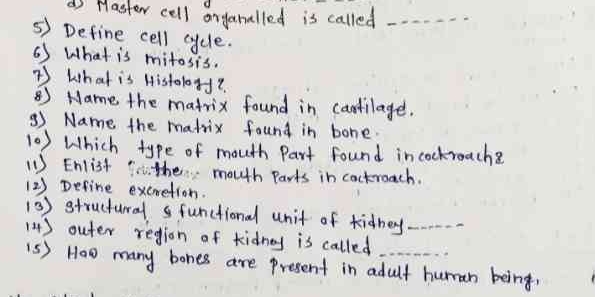5) Define cell cycle. 6) What is mitosis. 7) What is histology? 8) Name the matrix found in cartilage. 9) Name the matrix found in bone. 10) Which type of mouth part is found in co... 5) Define cell cycle. 6) What is mitosis. 7) What is histology? 8) Name the matrix found in cartilage. 9) Name the matrix found in bone. 10) Which type of mouth part is found in cockroaches? 11) Enlist the mouth parts in cockroach. 12) Define excretion. 13) What is the structural and functional unit of the kidney? 14) What is the outer region of the kidney called? 15) How many bones are present in an adult human being?

Understand the Problem
The image contains a list of biology questions related to cell biology, histology, zoology and anatomy. The questions require defining terms, naming structures, and enlisting parts of the body and their functions.
Answer
Here are the answers to your questions: 5) Cell cycle: The series of events that take place in a cell leading to its division and duplication of its DNA to produce two new daughter cells. 6) Mitosis: A type of cell division that results in two daughter cells each having the same number and kind of chromosomes as the parent nucleus, typical of ordinary tissue growth. 7) Histology: The study of the microscopic structure of tissues. 8) Cartilage matrix: Chondrin. 9) Bone matrix: Ossein. 10) Cockroach mouthparts: Biting and chewing type. 11) Mouthparts of cockroach: Labrum, Mandibles, Maxillae, Labium and Hypopharynx. 12) Excretion: The process of eliminating or expelling waste matter. 13) Structural and functional unit of kidney: Nephron. 14) Outer region of the kidney: Cortex. 15) Number of bones in an adult human being: 206.
Here are the answers to your questions: 5) Cell cycle: The series of events that take place in a cell leading to its division and duplication of its DNA to produce two new daughter cells. 6) Mitosis: A type of cell division that results in two daughter cells each having the same number and kind of chromosomes as the parent nucleus, typical of ordinary tissue growth. 7) Histology: The study of the microscopic structure of tissues. 8) Cartilage matrix: Chondrin. 9) Bone matrix: Ossein. 10) Cockroach mouthparts: Biting and chewing type. 11) Mouthparts of cockroach: Labrum, Mandibles, Maxillae, Labium and Hypopharynx. 12) Excretion: The process of eliminating or expelling waste matter. 13) Structural and functional unit of kidney: Nephron. 14) Outer region of the kidney: Cortex. 15) Number of bones in an adult human being: 206.
Answer for screen readers
Here are the answers to your questions: 5) Cell cycle: The series of events that take place in a cell leading to its division and duplication of its DNA to produce two new daughter cells. 6) Mitosis: A type of cell division that results in two daughter cells each having the same number and kind of chromosomes as the parent nucleus, typical of ordinary tissue growth. 7) Histology: The study of the microscopic structure of tissues. 8) Cartilage matrix: Chondrin. 9) Bone matrix: Ossein. 10) Cockroach mouthparts: Biting and chewing type. 11) Mouthparts of cockroach: Labrum, Mandibles, Maxillae, Labium and Hypopharynx. 12) Excretion: The process of eliminating or expelling waste matter. 13) Structural and functional unit of kidney: Nephron. 14) Outer region of the kidney: Cortex. 15) Number of bones in an adult human being: 206.
More Information
The nephron is the kidney's functional unit. It filters blood and processes urine.
Tips
Make sure that the scientific definitions are very precise, so include the maximum amount of relevant detail.
Sources
- Phases of mitosis | Mitosis | Biology (article) - Khan Academy - khanacademy.org
- Mitosis (Definition, Diagram & Stages Of Mitosis) - BYJU'S - byjus.com
- 6.2 The Cell Cycle – Concepts of Biology – 1st Canadian Edition - opentextbc.ca
AI-generated content may contain errors. Please verify critical information